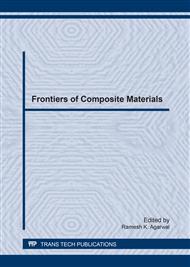[1]
Hepworth, D.G., et al., The use of unretted hemp fibre in composite manufacture. Composites Part A: Applied Science and Manufacturing, 2000. 31(11): pp.1279-1283.
DOI: 10.1016/s1359-835x(00)00098-1
Google Scholar
[2]
Wambua, P., J. Ivens, and I. Verpoest, Natural fibres: can they replace glass in fibre reinforced plastics? Composites Science and Technology, 2003. 63(9): pp.1259-1264.
DOI: 10.1016/s0266-3538(03)00096-4
Google Scholar
[3]
Herrera-Franco, P.J. and A. Valadez-González Mechanical properties of continuous natural fibre-reinforced polymer composites. Composites Part A: Applied Science and Manufacturing, 2004. 35(3): pp.339-345.
DOI: 10.1016/j.compositesa.2003.09.012
Google Scholar
[4]
Shah, D., et al., Hydroxyethylcellulose surface treatment of natural fibres: the new twist, in yarn preparation and optimization for composites applicability. Journal of Materials Science, 2012. 47(6): pp.2700-2711.
DOI: 10.1007/s10853-011-6096-1
Google Scholar
[5]
Holbery, J. and D. Houston, Natural-fiber-reinforced polymer composites in automotive applications. JOM Journal of the Minerals, Metals and Materials Society, 2006. 58(11): pp.80-86.
DOI: 10.1007/s11837-006-0234-2
Google Scholar
[6]
Stamboulis, A., C.A. Baillie, and T. Peijs, Effects of environmental conditions on mechanical and physical properties of flax fibers. Composites Part A: Applied Science and Manufacturing, 2001. 32(8): pp.1105-1115.
DOI: 10.1016/s1359-835x(01)00032-x
Google Scholar
[7]
Kalia, S., B.S. Kaith, and I. Kaur, Pretreatments of natural fibers and their application as reinforcing material in polymer composites—A review. Polymer Engineering & Science, 2009. 49(7): pp.1253-1272.
DOI: 10.1002/pen.21328
Google Scholar
[8]
Chaishome, J., et al., Thermal Degradation of Flax Fibres as Potential Reinforcement in Thermoplastic Composites, Advanced Materials Research, vol. 894, pp.32-36, (2014).
DOI: 10.4028/www.scientific.net/amr.894.32
Google Scholar
[9]
John, M.J. and R.D. Anandjiwala, Chemical modification of flax reinforced polypropylene composites. Composites Part A: Applied Science and Manufacturing, 2009. 40(4): pp.442-448.
DOI: 10.1016/j.compositesa.2009.01.007
Google Scholar
[10]
Goda, K. and Y. Cao, Research and Development of Fully Green Composites Reinforced with Natural Fibers. Journal of Solid Mechanics and Materials Engineering, 2007. 1(9): pp.1073-1084.
DOI: 10.1299/jmmp.1.1073
Google Scholar
[11]
Rana, A., Development and Characterization of Compression Molded Flax Fiber-reinforced Biocomposites, in Department of Agricultural and Bioresource Engineering. 2008, University of Saskatchewan: Saskatoon, Saskatchewan. p.159.
Google Scholar
[12]
De Rosa, I.M., et al., Effect of chemical treatments on the mechanical and thermal behaviour of okra (Abelmoschus esculentus) fibres. Composites Science and Technology, 2011. 71(2): pp.246-254.
DOI: 10.1016/j.compscitech.2010.11.023
Google Scholar


